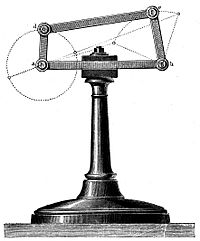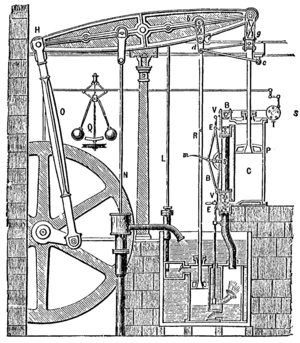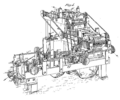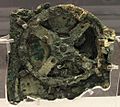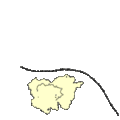Machine facts for kids
A machine is a tool or device made by people to help make work easier. Machines can do many jobs, from lifting heavy things to helping us communicate.
Some machines have parts that move, like a bicycle or a clock. Other machines, like computers and telephones, do not have many moving parts.
People have used machines for a very long time, even before written history. Often, a machine changes one type of energy into another. Simple machines can also make a force stronger or change its direction.
Contents
- History of Machines
- Simple Machines: The Basics
- How Modern Machines Work
- Power Sources for Machines
- Machine Parts and How They Move
- Machine Controllers
- Computing Machines
- Tiny Machines: Molecular Machines
- How Machines Change Our World
- Understanding Mechanics
- Designing Machines
- Images for kids
- See also
History of Machines

One of the earliest tools was the hand axe. It was made by chipping flint stone into a wedge shape. When a person used it, the axe changed their effort and movement into a strong splitting force. This made it easier to cut or split things.
The idea of simple machines began with the Greek thinker Archimedes around 300 BC. He studied the lever, pulley, and screw. Archimedes figured out how the lever could give a "mechanical advantage". This means it could make a small force do a lot of work. Later, other Greek thinkers added more simple machines to the list.
Hero of Alexandria (around 10–75 AD) wrote about five simple machines: the lever, windlass, pulley, wedge, and screw. He described how to make and use them. However, the Greeks mostly understood how forces balanced, not how machines used energy or did work.
During the Renaissance, people started to study how much useful work simple machines could do. This led to the modern idea of mechanical work. In 1586, Simon Stevin explained how the inclined plane worked, and it was added to the list of simple machines.
Galileo Galilei was an Italian scientist who fully explained the theory of simple machines in 1600. He was the first to understand that machines do not create energy. Instead, they just change it from one form to another.
Leonardo da Vinci (1452–1519) discovered the rules of friction in machines. But his notes were not published. Later, other scientists like Guillaume Amontons (1699) and Charles-Augustin de Coulomb (1785) rediscovered and developed these ideas.
James Watt invented a special part for the steam engine in 1782. This made the steam engine much more useful. Steam engines then powered steam locomotives, steam ships, and factories.
The Industrial Revolution was a huge change from 1750 to 1850. It started in the United Kingdom and spread worldwide. During this time, many jobs that used to be done by hand or with animals started to be done by machines. This included making textiles, working with iron, and using coal.
Simple Machines: The Basics
The idea that machines are made of simple moving parts led to the definition of simple machines. The main simple machines are the lever, pulley, screw, wheel and axle, wedge, and inclined plane. Modern ideas about machines also look at the parts that allow movement, called joints.
Wedge (like a hand axe): The hand axe is a very old example of a tool that helps manage power. It is a wedge made from stone. A wedge changes a pushing force into a splitting force. It makes the force stronger by spreading it over a smaller distance. This "mechanical advantage" helps you split wood or cut things more easily.
Lever: The lever is another important simple machine. It is a stiff bar that pivots around a point called a fulcrum. If you push down far from the fulcrum, you can lift a much heavier weight closer to the fulcrum. This is because the part far from the fulcrum moves a greater distance. The lever's mechanical advantage depends on the distances from the fulcrum.
Wheel: The wheel is a very important early machine, like those used on a chariot. A wheel uses the idea of the lever to reduce the force needed to move something. When you pull a load on wheels, the main friction is in the wheel's bearing. The wheel acts like a lever, making your pulling force strong enough to overcome this friction.
A scientist named Franz Reuleaux studied many different machines. He realized that simple machines can be grouped. Levers, pulleys, and wheels rotate around a hinge. Inclined planes, wedges, and screws involve a block sliding on a flat surface.
This shows that the connections, or "joints," that allow movement are key parts of a machine. By understanding different types of joints (like rotating, sliding, or gear joints), we can see a machine as parts connected by these joints. This is called a mechanism.
For example, two levers can be joined together to form a four-bar linkage. This is a basic part of many machines, like the suspension in a car or the arm of a robot.
How Modern Machines Work
Modern machines are like complex systems. They have:
- A power source and actuators that create force and movement.
- A system of mechanisms that shapes this movement for a specific job.
- A controller with sensors that check how well the machine is working. It then tells the actuators what to do.
- An interface for a person to use, with things like levers, switches, and screens.
Think about Watt's steam engine (shown in the picture). Steam pushes a piston, which provides the power. A system of levers and cranks changes the piston's straight movement into the turning motion of a pulley. A special part called a "flyball governor" then controls the steam going into the engine, keeping it running smoothly.
The word "mechanical" often refers to things related to machines or tools. It also means something caused by movement or physical forces.
Scientists like Franz Reuleaux and others have described a machine as a combination of parts that work together. They use natural forces to do work and create specific movements.
Power Sources for Machines
Early machines used human or animal effort for power. Later, natural forces like wind and water were used for bigger machines.
Waterwheel: Waterwheels appeared around 300 BC. They used flowing water to create turning motion. This power was used for grinding grain, cutting wood, and powering factories. Today, water turbines use water flowing through a dam to spin an electric generator, making electricity.
Windmill: Early windmills captured wind power to turn grinding stones. Modern wind turbines also use wind to spin a generator, creating electricity. This electricity can then power motors in other machines.
Engine: The word "engine" comes from "ingenuity." An steam engine uses heat to boil water, creating steam. The expanding steam pushes a piston or a turbine. This is an "external combustion engine" because the fuel is burned outside the main working parts.
An automobile engine is an "internal combustion engine" because it burns fuel inside a cylinder. The expanding gases push a piston. A jet engine also burns fuel inside to create thrust for an aircraft.
Power plant: In a power plant, burning coal or natural gas heats water to make steam. This steam spins a steam turbine, which turns an electric generator to make electricity. Nuclear power plants use heat from a nuclear reactor to do the same thing. This electricity is then sent through power lines to homes and factories.
Motors: Electric motors use electricity (either AC or DC) to create turning movement. Electric servomotors are special motors that can position a shaft very accurately. They are used in robots and modern aircraft.
Fluid Power: Hydraulic and pneumatic systems use pumps to push water or air into cylinders. This creates strong straight-line movement.
Machine Parts and How They Move
The mechanism of a machine is made of parts called machine elements. These parts give the machine its structure and control how it moves.
Some parts provide structure, like the frame, bearings, springs, and seals. The outer covers of a machine also give it its look and how people interact with it.
The parts that control movement are also called "mechanisms." These include gears (and belt drives or chain drives), cams, and linkages. Other special mechanisms include indexing mechanisms (for precise stops) and brakes or clutches (for stopping or connecting movement).
The way a mechanism moves depends on how many parts it has and how they are connected by joints.
Structural Parts of Machines
Many machine parts have important structural jobs:
- The frame holds all the parts of a machine together. It's often made of strong truss or beam elements.
- Bearings are parts that help moving elements slide or rotate smoothly against each other. They help reduce friction.
- Splines and keys are ways to securely attach a wheel, pulley, or gear to a spinning axle. This makes sure the power is transferred correctly.
- Springs create forces that can hold parts in place or act as a suspension to absorb shocks.
- Seals are used between parts to stop liquids or gases from leaking out, like in an engine.
- Fasteners like screws, bolts, and rivets are used to put machine parts together. Fasteners can usually be removed. Other ways of joining parts, like welding or adhesives, are usually permanent.
Machine Controllers
Controllers use sensors (which detect things), logic (which makes decisions), and actuators (which make things move) to keep a machine working correctly. A famous example is the flyball governor on a steam engine, which controls its speed.
Other examples include a thermostat that opens a valve to cool water when the temperature rises. Or a cruise control system in a car that keeps a steady speed. Modern machines often use programmable computers to control their actions. Servomotors are special motors that can be precisely controlled, making robotic systems possible.
Computing Machines
In 1837, Charles Babbage designed machines to calculate numbers. His Difference engine was like an advanced mechanical calculator. His Analytical Engine was an early idea for a modern computer, even though it wasn't built in his lifetime.
Machines like the Arithmometer and the Comptometer were mechanical computers that came before today's digital computers.
Tiny Machines: Molecular Machines
Even at the tiny level of molecules, there are machines! For example, the biological molecule myosin helps muscles contract. It changes shape and pulls on another molecule called actin, creating force.
Another molecule, kinesin, moves along tiny tracks in cells, carrying important packages. These molecules are sometimes called nanomachines because they work like tiny machines. Scientists have even used DNA to build tiny linkages at the nano-level.
How Machines Change Our World
Mechanization and Automation
Mechanization means using machines to help people with physical work. It can be as simple as using hand tools, but usually it means more complex machines. For example, machines that change speed or motion using gears, pulleys, or cams are considered mechanized. After electricity became common, mechanization often meant using motorized machines.
Automation goes a step further than mechanization. It means using control systems and computer systems to reduce the need for human work. While mechanization helps with physical tasks, automation also reduces the need for human thinking and senses. Automation is becoming more and more important in the world economy and in our daily lives.
Automata
An automaton is a machine that operates by itself. Sometimes, this word is used to describe a robot, especially one that can act on its own. A "Toy Automaton" was first patented in 1863.
Understanding Mechanics
Hero of Alexandria studied how to lift heavy weights. Today, mechanics is the study of the forces and movements of machines. It looks at how parts move (kinematics) and how forces cause that movement (dynamics).
How Machines Move (Dynamics)
When studying how machines move, scientists first imagine the parts as rigid bodies (meaning they don't bend). This helps them figure out the forces at the connections. Rigid-body dynamics studies how connected parts move when forces act on them. By assuming the parts are rigid, it simplifies the math.
The movement of a rigid body system is described by its equations of motion. These equations help scientists understand how the machine's parts change position over time. This is very useful for computer simulations of machines.
The Study of Machine Motion (Kinematics)
To understand how a machine works, you need to know how its parts move. This is called kinematics. If you assume the parts are rigid, their movement can be described using math. This helps scientists figure out the position, speed, and acceleration of every point in a machine part.
Designing Machines
Machine design involves several steps throughout a machine's life:
- Invention: This is where people figure out what is needed, create ideas, build test models, and make the machine.
- Performance engineering: This means making the machine work better. It includes making it easier to build, reducing maintenance, adding new features, and making sure it works well.
- Recycle: This is the final stage, where the machine is taken apart. Materials and parts can be recovered and reused.
Images for kids
-
A Honda F1 racecar engine.
-
An early Ganz Electric Generator.
-
The Antikythera mechanism (main fragment), an ancient Greek device.
-
A ribosome is a biological machine that builds proteins.
See also
 In Spanish: Máquina (tecnología) para niños
In Spanish: Máquina (tecnología) para niños




